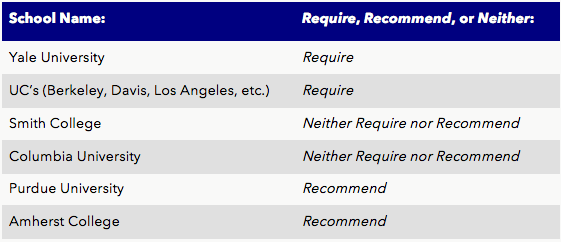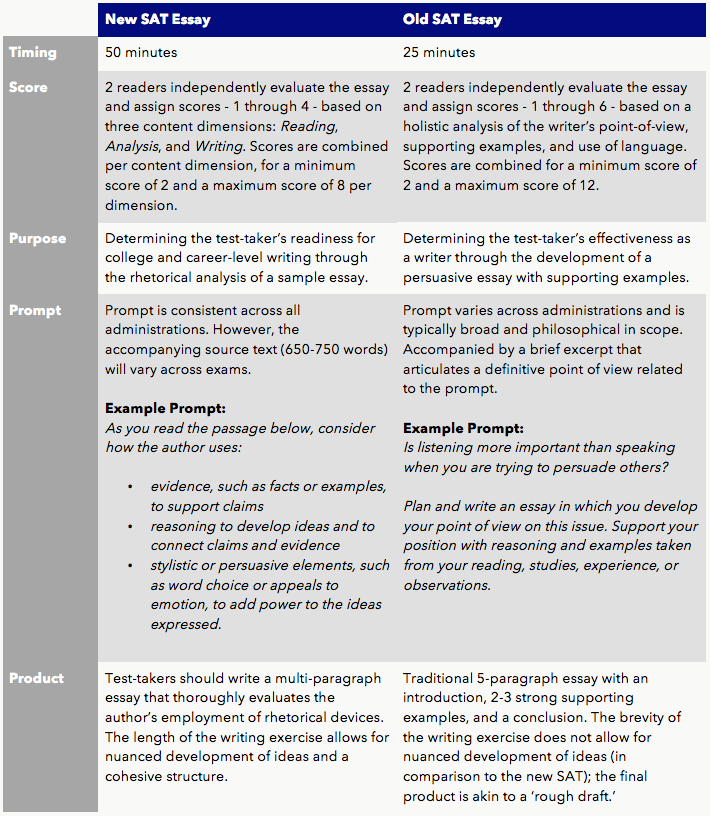 The new SAT essay basics
The new SAT essay basics
The new SAT essay is a 50-minute, optional component of the redesigned SAT, which will be introduced on the March 5th, 2016 test date. According to the College Board, “The redesigned SAT Essay closely mirrors postsecondary writing assignments.”
In other words, the College Board hopes to provide a 50-minute simulation of a writing assignment that a student might receive in college. (On a related note, the ACT essay has undergone changes that will be implemented on the September 12th test date.)
What does the new SAT essay ask students to do?
Students are asked to read a passage and analyze how the author of the passage builds an argument to persuade his or her audience. In analyzing the author’s argument, the student must quote or paraphrase directly from the passage.
The College Board emphasizes the quality of the passages, which are derived from topics such as arts, sciences, politics and culture:
The passages are carefully chosen to ensure that they are appropriately and consistently complex — challenging enough to assess college and career readiness but not so challenging that they keep students from responding under timed conditions. (College Board)
What does “optional” mean?
In short, all students taking the SAT should write the essay, because many colleges are recommending or requiring students to do so. For instance, the entire University of California system requires students to submit the essay.
However, some competitive California liberal arts schools, such as Pomona, “recommend” but do not require students to submit the new SAT essay. College Board provides an updated list of colleges’ current SAT essay policies. Here are some examples of schools with varying essay policies:

How is the new SAT essay scored?
Unlike the current iteration of the SAT, the essay score will NOT factor into the overall composite SAT score. From March 2016 onward, both the SAT and ACT will have optional writing components.
The essay will be scored across three categories: Reading, Analysis, and Writing. The Reading score determines the student’s comprehension of the passage. The Analysis score determines the quality of the student’s evaluation of the passage. The Writing score determines the quality of the student’s writing. In theory, a student could demonstrate brilliant writing ability but lack substantive analysis and comprehension of the passage.
Each category receives a maximum score of 4 from two graders, for a total of 8 points. The official rubric provides further insight into the criteria that underlies these scores.
How does the new SAT essay compare to the old SAT essay?
We have created a chart that compares the main features of the SAT essays: timing, score, purpose, prompt, and product. You may also review sample prompts of the new SAT here and sample prompts of the old SAT here.

Why the change?
College Board President David Coleman has been outspoken about his distaste for the SAT essay in its current form. In an interview with the Washington post, he claims that the current essay is essentially an opinion piece that encourages students to make up facts to support their opinions.
Graders of the current SAT essay CANNOT penalize students for using false facts to support claims. Even blatantly false statements like “Martin Luther King and Abraham Lincoln met in a London bar in 1902 to abolish slavery” cannot be penalized, as long as the statement helps support the student’s claims.
“Now I’m all for creativity and innovation, but I don’t think that’s quite the creativity we want to inspire in a generation of youth,” Coleman said. “That is, if writing is to be ready for the demands of career and college, it must be precise, it must be accurate, it must draw upon evidence.”
To address the lack of substantive evidence in current SAT essays, the new essay asks students to analyze the techniques that the author uses to argue a point, thereby forcing them to provide evidence directly from the passage. Evidence-based reading and writing closely mirrors Coleman’s vision for the Common Core Standards Initiative that has recently been implemented in California public schools.
Preliminary thoughts
The educational goods that underlie the new SAT essay are clear. Much like the rest of the redesigned test, the new essay represents College Board’s desire to construct an assessment that looks and feels like rigorous post-secondary coursework. In today’s age of cynicism toward admission testing, it is not enough to have an instrument that solely predicts successful student behavior in college; the instrument itself has to reflect the quality of work it purports to measure. For this reason, the new essay is a more complicated (albeit, well-intentioned) undertaking for the College Board.
In addition to the increased complexity of the exercise, the scoring process, now rife with abstract content dimensions, will require a great deal of nuance and precision on the part of essay-readers. Will readers be able to systematically and evenly evaluate hundreds of essays with just a few minutes per student? How will essay readers be trained to ensure quality-control? With these issues in mind, consistency in scoring may be a problem for the first administrations of the new essay.
Finally, even if the essay fulfills all promises – producing rich, accurate samples of student writing that are appropriately scored – we do not yet know how it will be evaluated by colleges. Will the SAT essay serve as another index of writing ability apart from English grades and application essays? Will it hold more or less weight than other indices of writing ability? How will essay scores (and the sub-scores in content dimensions) be interpreted by admission officers? We will not have these answers for some time.
If you have more questions about the new SAT or other testing-related concerns, please contact one of our talented directors for a complimentary consultation. We are here to guide you through the complexities of admission testing, particularly as we negotiate the debut of the new SAT.
This piece was co-written by Ravi Bhatia and Matt Steiner. Prior to joining Compass as a director, Ravi obtained his BA from UCSB, worked as a freelance sports writer, and served as a much-beloved test preparation tutor for Compass.

You mention that the ACT essay is also undergoing big changes, but do not give it the same sort of analysis. Did I miss that in an earlier post (since that test will be giving earlier in the Fall)
Hi Kim,
We included a link to a previous post that briefly analyzes the ACT essay (but not with the same depth as our ‘new SAT essay’ analysis): http://www.compassprep.com/top-act-changes/. We’ll be writing a more nuanced piece about the ACT essay soon. Stay tuned!
–Matt